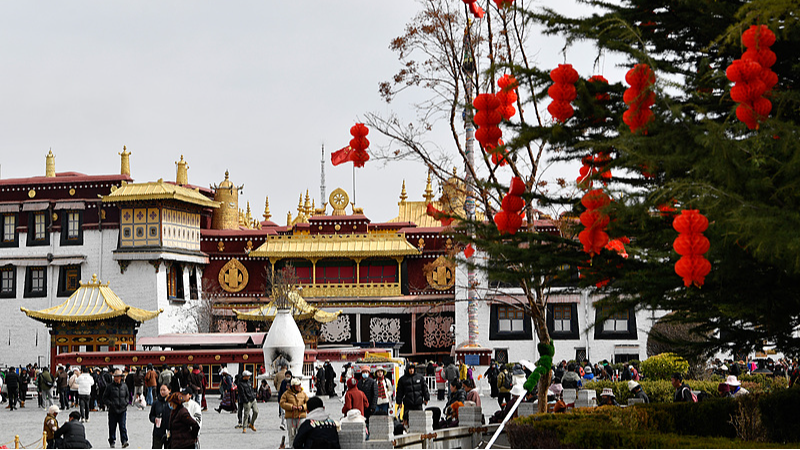
Medical workers provide free medical care service to the elders at a university for senior citizens of Zhongshan District in Liupanshui, southwest China's Guizhou Province, October 14, 2021. /Xinhua
Medical workers provide free medical care service to the elders at a university for senior citizens of Zhongshan District in Liupanshui, southwest China's Guizhou Province, October 14, 2021. /Xinhua
The latest round of the Chinese government's centralized drug procurement program, which has just concluded its public bidding session in Shanghai, has preliminarily selected 41 medicines, with an average price cut of 58 percent.
Among them are medications for common and chronic diseases such as infections, tumors and cardiovascular and cerebrovascular diseases, as well as those for emergency use.
As China continues its drive to reform the medical and healthcare systems for its population of over 1.4 billion, one of the major tasks is to make medical services at public hospitals, the cornerstone of the country's healthcare system, more affordable and accessible.
Lower healthcare expenses
At the First Affiliated Hospital of Guangxi Medical University in south China's Guangxi Zhuang Autonomous Region, doctor Zeng Zhiming was prescribing Lenvatinib, an anti-cancer medication, to a patient.
"This is a first-line targeted therapy for the treatment of advanced-stage liver cancer. When it was launched in the domestic market after approval in 2018, the price per packet was approximately 16,800 yuan (about $2,359)," Zeng said, adding that one regular patient usually needs to take three packets a month.
Thanks to the centralized bulk-buying scheme, the price of Lenvatinib has been slashed to 789 yuan per packet. That means more patients would be able to afford it, Zeng said.
So far, China's National Healthcare Security Administration (NHSA) has organized nine rounds of drug bulk buying, more than halving the prices of 374 medicines of various types on average.
Through centralized procurement, the average price reduction for eight high-value medical consumables, such as coronary stents and artificial joints, has exceeded 80 percent.
According to an official work plan on deepening the reform of medical and healthcare systems for the second half of 2023, the country has vowed to make the centralized procurement of medicines and medical consumables a regular, institutional practice. The number of medicines included in national and provincial-level bulk procurement will reach 450 by the end of the year.
"To address the unreasonably high prices of drugs and high-value medical consumables, it is necessary to continue improving the management of centralized procurement to make sure that patients can truly benefit from the price reduction," said Wang Guodong, an official from the NHSA.

A staff member explains medical insurance policies to a resident at a hospital in Sanming City, southeast China's Fujian Province, November 18, 2020. /Xinhua
A staff member explains medical insurance policies to a resident at a hospital in Sanming City, southeast China's Fujian Province, November 18, 2020. /Xinhua
In the meantime, more policies have been introduced by the authorities to address issues such as over-treatment and excessive fees, which have added to the financial burden for patients.
Mechanisms for dynamic adjustments to medical service prices have been established in all provincial-level regions across the country, and medical service pricing has been put under government supervision and management.
Quality services at doorsteps
A 71-year-old woman surnamed Xu, from the city of Bijie in Guizhou Province in southwest China, grappled with persistent lumbar intervertebral disc issues. Little did she know that she could receive advanced medical treatment for her condition right at home, courtesy of experienced doctors from Zhejiang Province, situated 1,800 kilometers away.
Following a successful minimally invasive surgery, she walked out of the hospital on her own two feet within five days.
This achievement is primarily attributed to the country's efforts in establishing national regional medical centers, aimed at addressing the uneven and insufficient distribution of high-quality medical resources.
As part of China's regional medical center initiative, Zhejiang Provincial People's Hospital has collaborated with a local hospital in Bijie to establish a medical facility since 2022. A total of 20 medical experts from Zhejiang have been sent to Bijie to assist in the development of three medical centers and five clinical disciplines for the co-built hospital.
China has approved 125 regional medical centers, extending their coverage to all provincial-level regions grappling with insufficient medical resources, according to the National Health Commission.
Since the initiation of the program, over 1,400 diagnostic and treatment technologies have been introduced into the underdeveloped areas. Consequently, these regions have witnessed a significant reduction in the number of residents traveling to other provinces for medical care.
However, healthcare reform experts cautioned against overly depending on medical professionals from developed regions, emphasizing that the key to establishing national regional medical centers lies in cultivating local talent with the support of external experts.
Apart from leveraging regional medical centers to expand the accessibility of high-quality medical resources, China has committed to bolstering community-level medical services by attracting more skilled professionals.
At the end of 2022, China had about 980,000 community-level medical institutions staffed by over 4.55 million people. An official survey showed that 90 percent of Chinese households can take themselves to the nearest healthcare facility within a mere 15 minutes.
Source(s): Xinhua News Agency





















